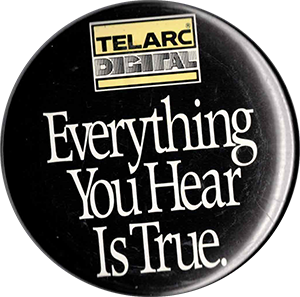High Fidelity and Audiophilia
“If a thing is worth doing, it is worth doing well.” This quote, variously attributed to Oscar Wilde, Evelyn Waugh, and others, could sum up the philosophy of the audiophile. Or perhaps Robert Heinlein’s version is more appropriate: “If a thing’s worth doing, it’s worth overdoing.”1 Audiophiles are listeners who strive for the highest possible fidelity, or sonic quality, in their listening experience. Often this results in considerable investment in playback systems.2 While this makes audiophiles an easy target for ridicule, this passion can also drive significant advancements in the technology of recording.3 Telarc was among the companies driven by that passion.
The quest for quality sound reproduction reaches back to the earliest days of recording. In The Audible Past, cultural historian Jonathan Sterne explored the notion of fidelity in recorded sound:
Those who are dismissive of new audio technology are often quite passionate in their disdain. In December of 1985, critic Edward Rothstein wrote in The New Republic that the digital audio technology employed in CDs is vastly inferior to analog: “A recording can be rich with detail and nuance, while the CD sounds musically raw and untamed, like a recounting of the same musical event by someone with a strong voice but slightly bad hearing.”7 The term recording in this case refers to an LP; Rothstein won’t even use this generic term in reference to a compact disc! Addressing Rothstein’s criticisms is beyond the scope of this project, but suffice it to say that Telarc’s engineers and consumers would beg to differ.
Gathering reliable data on the topic of sound quality preferences is notoriously difficult. Members of the Audio Engineering Society have published numerous papers on the topic. One 2004 study found that there is indeed a discernible difference between the two leading high-resolution digital coding formats.8 A 2016 meta-analysis which looked at a collection of similar studies concluded that there was none.9 A 2014 convention paper digs into exactly how difficult it is to conclusively answer the question in the first place.10 And a 2019 paper found that, unsurprisingly, the answer to the question of differences in audio quality depends very much on whom one asks!11
The quest for the highest possible quality of sound recording and reproduction continues in the present day. Jonathan Sterne challenges us with this note: “after 1878, every age has its own perfect fidelity.”12 Or in other words, there will always be room for improvement in the quest for perfect sound recording and reproduction.
An infographic of the history of home audio technology may be found here.
Last updated on January 31st, 2025 at 04:11 pm
- Spoken by the perdurable character Lazarus Long, who appears in several Heinlein stories. ↩︎
- For example, one set of loudspeakers currently on the market clocks in at $107,395.00. (www.kronosav.com, accessed March 28, 2024) ↩︎
- British comedy duo Flanders and Swann lampooned the Hi-Fi mentality in their “Song of Reproduction.” Lyrics here, recording here (played on an audiophile turntable). ↩︎
- Jonathan Sterne, The Audible Past : Cultural Origins of Sound Reproduction (Durham: Duke University Press, 2003), 221. ↩︎
- Henry Hartley, Audio Design Handbook (New York: Gernsback Library, 1958), 200. Hartley’s book aims “to bring together in compact form all the material necessary for designing an audio installation of the type known as ‘high fidelity.’” ↩︎
- Kenneth W. Johnson, The Science of Hi-Fidelity, 2nd edition (Kendall Hunt Pub Co, 1981). ↩︎
- Edward Rothstein, “The Quest for Perfect Sound,” New Republic 193, no. 27 (12AD), 30. ↩︎
- Dominic Blech and Min-Chi Yang, “DVD-Audio versus SACD: Perceptual Discrimination of Digital Audio Coding Formats,” in Audio Engineering Society Convention 116, 2004. ↩︎
- Joshua D. Reiss, “A Meta-Analysis of High Resolution Audio Perceptual Evaluation,” J. Audio Eng. Soc 64, no. 6 (2016): 364–79. ↩︎
- Atsushi Marui et al., “Subjective Evaluation of High Resolution Recordings in PCM and DSD Audio Formats,” in Audio Engineering Society Convention 136, 2014. ↩︎
- Will Howie et al., “Effect of Audio Production Experience, Musical Training, and Age on Listener Performance in 3D Audio Evaluation,” J. Audio Eng. Soc 67, no. 10 (2019): 782–94. ↩︎
- Sterne, The Audible Past, 222. ↩︎
